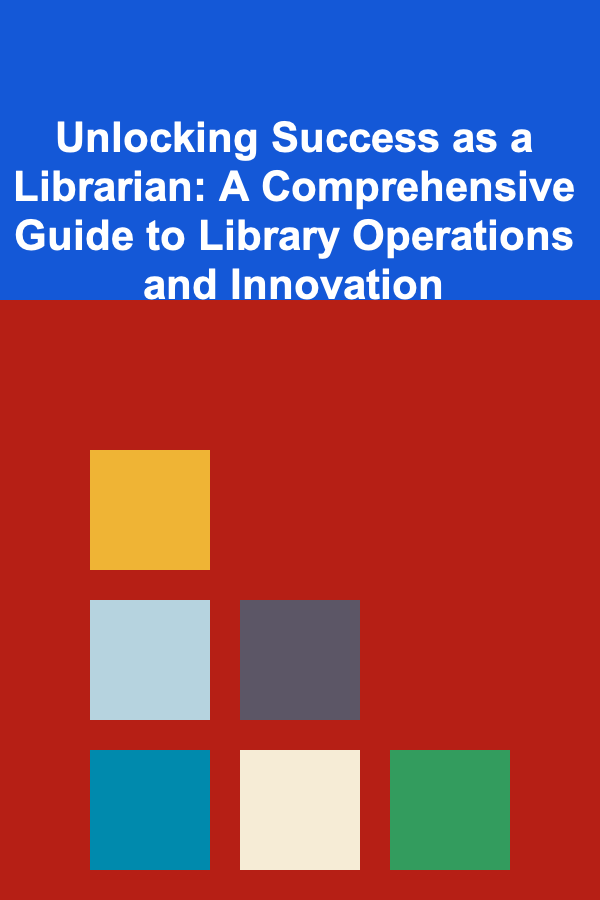
Unlocking Success as a Librarian: A Comprehensive Guide to Library Operations and Innovation
ebook include PDF & Audio bundle (Micro Guide)
$12.99$9.99
Limited Time Offer! Order within the next:

In the fast-evolving landscape of libraries, librarians are no longer just custodians of books and information. They have become essential drivers of innovation, digital transformation, and community engagement. The role of the librarian is dynamic, and to succeed, one must understand how to operate efficiently while also embracing new technologies and innovative practices. This guide offers an actionable roadmap for librarians seeking to unlock success, both in traditional library operations and in the realm of library innovation.
Understanding Core Library Operations
A successful librarian must first master the core operations that define the library's functionality. These essential practices include collection management, resource accessibility, circulation management, and user services.
Collection Development and Management
The foundation of any library lies in its collection---its books, journals, databases, and multimedia resources. Building and managing a collection that meets the diverse needs of patrons is crucial for ensuring relevance and effectiveness.
Curating a Balanced Collection
Successful collection development starts with a well-thought-out strategy. Librarians should strive to create collections that balance a variety of content types:
- Print and Digital Materials: While digital formats are increasingly popular, maintaining a balance with print materials is essential. Print books still serve certain groups of users better (e.g., young readers or those who prefer tactile engagement), while digital formats (e-books, audiobooks) offer convenience for others.
- Subject Diversity: A well-rounded collection should cater to different interests, from science and technology to the arts, social sciences, and humanities. It should also reflect local needs, offering resources in multiple languages or addressing local history and cultural heritage.
- New Acquisitions: Keep the collection current by constantly reviewing new releases, trends, and emerging research. This process involves using data analytics to predict demand and solicit feedback from patrons on what resources they need most.
Regular Evaluation and Weeding
Collection management isn't just about adding new resources; it also involves regular evaluation of existing materials. Weeding out outdated, damaged, or irrelevant items ensures that the collection remains useful and accessible.
- Usage Statistics: Utilize software that tracks how often items are borrowed to identify those that are underused and assess whether they should be removed or replaced.
- Condition Checks: Regularly inspect materials to ensure they are in good condition. Items that are physically damaged can be replaced or digitized to ensure continued access.
Cataloging and Classification Systems
Efficient cataloging is key to ensuring that patrons can find resources easily. A librarian must be well-versed in classification systems such as the Dewey Decimal Classification (DDC) or Library of Congress Classification (LCC).
- Digital Cataloging: Many libraries now use integrated library systems (ILS) or online public access catalogs (OPACs) to maintain their collections. It's important for librarians to ensure these systems are properly updated and accessible.
- Metadata Management: Proper metadata tagging helps users search for items more efficiently. For digital resources, effective metadata strategies can increase discoverability.
User Services and Circulation
The interaction between librarians and patrons is central to library success. User services encompass everything from assisting with research and information retrieval to providing library programs.
- Reference and Research Assistance: Librarians should provide expert assistance to patrons who need help with research. This includes guiding users to reliable sources, teaching information literacy, and assisting with citation management.
- Technology Integration: Libraries today integrate technology into circulation, allowing users to check out materials through self-checkout stations, renew items online, or access digital content remotely. This seamless service fosters positive user experiences.
Managing Library Facilities
The library facility itself plays a significant role in user satisfaction. Efficient management of physical spaces---study rooms, reading areas, and multimedia labs---is essential for creating an inviting environment.
- Space Planning: Libraries should offer spaces that cater to a variety of needs: quiet study areas for individual work, collaborative spaces for group projects, and flexible spaces that can be adapted for events or workshops.
- Maintenance and Safety: Regular maintenance is essential to ensure that the library remains clean, safe, and comfortable for patrons.
Driving Innovation in the Library
In addition to traditional operations, librarians need to embrace innovation. By integrating new technologies, fostering community-driven programs, and adapting to changing user expectations, libraries can become more relevant and impactful in today's society.
Digital Transformation
As libraries continue to modernize, digital transformation becomes a cornerstone of their operations. The rise of digital resources, such as e-books, databases, and online journals, has reshaped how libraries serve their patrons.
E-Libraries and Virtual Access
Offer patrons access to digital content through e-libraries. These virtual libraries allow users to borrow e-books, audiobooks, and academic resources remotely. It's essential for librarians to:
- Implement Digital Lending Platforms: Platforms like OverDrive, Hoopla, and Libby allow users to borrow digital materials from the library. These tools offer an extensive range of digital resources and help cater to the growing demand for digital content.
- Provide Remote Research Support: Offer online reference services such as email assistance, chat services, or virtual appointments to help patrons access resources remotely.
Embracing Emerging Technologies
Librarians can take advantage of emerging technologies to enhance both user experience and collection management:
- Artificial Intelligence (AI): AI can be used to enhance cataloging processes, manage user requests, and even suggest resources to users based on their previous interactions. Librarians can explore how AI-powered tools like chatbots or recommendation engines can provide personalized user experiences.
- 3D Printing and Maker Spaces: Many modern libraries have established maker spaces that feature 3D printing technology, allowing patrons to create prototypes, models, or other physical objects. Integrating such tools into library operations can attract innovative minds and foster creativity in the community.
Community Engagement and Programming
Beyond traditional resource sharing, modern librarians are community builders. Libraries can host a wide range of programs that cater to the needs and interests of diverse community groups.
Cultural and Educational Programs
Librarians can design events that educate, inspire, and engage patrons. Examples include:
- Author Readings and Talks: Invite authors, scholars, and experts to present their work to the public, fostering intellectual and cultural exchange.
- Workshops and Seminars: Offer hands-on workshops in various fields, such as coding, digital literacy, or creative writing, to empower patrons with new skills.
- Storytelling and Literacy Initiatives: Host reading programs for children, seniors, or English language learners to build literacy and encourage a love of reading.
Inclusive Programming
Libraries must also create inclusive spaces that serve marginalized and underserved communities. This includes offering:
- Multilingual Resources and Programs: Provide books and materials in multiple languages and host events for non-native speakers or immigrants.
- Accessibility Features: Ensure the library's resources and programs are accessible to people with disabilities, offering assistive technologies such as screen readers or hearing loops.
Collaboration and Partnerships
Librarians can drive innovation by collaborating with local organizations, businesses, and educational institutions. These partnerships open doors for new programming, shared resources, and extended community outreach.
- Academic Institutions: Partnering with schools or universities allows libraries to integrate academic resources into local curricula and offer research support.
- Local Organizations: Collaborating with community organizations provides libraries with opportunities to host joint events, such as health clinics, job fairs, or community outreach programs.
- Tech Companies: Partnerships with technology firms can help libraries stay on the cutting edge, providing resources like advanced software, hardware, and training.
Fostering a Culture of Continuous Learning
To thrive in today's dynamic library environment, librarians must adopt a mindset of continuous learning. Staying updated on industry trends, pursuing professional development opportunities, and engaging with the broader librarian community will enable librarians to adapt to new challenges and opportunities.
Professional Development
Librarians should invest in their own growth by attending conferences, workshops, and online courses. This not only helps them stay current on the latest trends but also allows them to build valuable professional networks.
- Certifications: Some librarians may pursue additional certifications in areas like digital librarianship, archives management, or library technology.
- Networking: Becoming involved in organizations like the American Library Association (ALA) or International Federation of Library Associations and Institutions (IFLA) provides opportunities for collaboration and knowledge sharing.
Embracing Innovation in Library Education
Libraries are also hubs for learning and training. Librarians must embrace the responsibility of teaching patrons new skills and offering cutting-edge resources.
- Information Literacy: Teach patrons how to navigate the vast array of information available to them, helping them critically evaluate sources and access reliable content.
- Digital Literacy: Offer courses that teach patrons how to use technology, from basic computer skills to advanced coding and digital content creation.
Conclusion
Becoming a successful librarian in the 21st century requires a blend of traditional expertise, innovative thinking, and a strong commitment to community engagement. By mastering core operations, embracing digital transformation, fostering collaboration, and continuously learning, librarians can unlock success and make a lasting impact on their communities. The library's future is bright, and with the right approach, librarians can shape that future with creativity, dedication, and a deep understanding of the evolving needs of their patrons.

How to Leverage Virtual Assistants for Marketing and Social Media Management in Dropshipping
Read More
How to Maintain an Organized Home After Decluttering
Read More
How to Make Money Online as a Blockchain Consultant: 10 Actionable Ideas
Read More
How to Turn Your Home Rental Property into a Passive Income Stream
Read More
How to Use Investment Apps to Manage Your Portfolio
Read More
The Virtual Assistant's Toolkit: Proven Techniques for Time Management and Client Relations
Read MoreOther Products

How to Leverage Virtual Assistants for Marketing and Social Media Management in Dropshipping
Read More
How to Maintain an Organized Home After Decluttering
Read More
How to Make Money Online as a Blockchain Consultant: 10 Actionable Ideas
Read More
How to Turn Your Home Rental Property into a Passive Income Stream
Read More
How to Use Investment Apps to Manage Your Portfolio
Read More